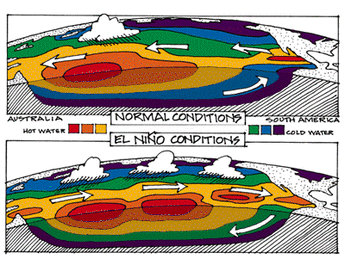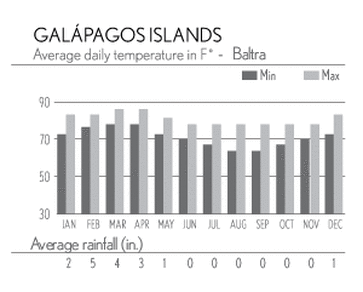"Considering that these islands are placed directly under the equator, the climate is far from being excessively hot; this seems chiefly cause by the singularly low temperature of the surrounding water, brought here by the great southern Polar current. Except during one short season, very little rain falls, and even then it is irregular; but the clouds generally hang low."
-Charles Darwin, The Voyage of the Beagle , 1845
The polar current that Charles Darwin speaks about in this quote from his journey on the hms Beagle would later become known as the Humboldt, or Peru, current. In specific, the Humboldt current is an ocean current, which is a flow of continuous water produced by anything from breaking waves and wind, to salinity and the Coriolis effect (the result from earth's rotation causing freely moving objects to veer toward the right in the Northern Hemisphere and to the left in the Southern Hemisphere). This cool current drifts north along the coast of Chile and Peru, and turns west to the Galapagos. Along with the Cromwell undercurrent, these cool flows of water are most prominent during the Garua (dry) season, which lasts from June to November. These currents bring with them cooler air, creating an inversion layer (areas where the normal decrease in air temperature with increasing altitude is reversed and air above the ground is warmer than the air below it). This can disturb the usual weather pattern linked to the tropics, due to the fact that the moisture that evaporates from the ocean is clustered in this layer. This means that only the higher elevations (such as Voclan Wolf on Isabela Island) receive rainfall during this time. Ironically enough, the highlands usually receive more rainfall than they would in the wet season.

Characteristics of El Nino
The wet season, which lasts from December to May, brings in the Northeast trade winds. This is also when the hot Panama Current flows in, heating the water's surface. When the water's surface meets the cold currents, convection (The transfer of heat or other atmospheric properties by massive motion within the atmosphere, especially by such motion directed upward) occurs, increasing precipitation. Much of this water simply soaks right through the porous volcanic rock that makes up much of the island's surface. Throughout an El Nino (the Nino) event, water temperatures in the central and eastern equatorial Pacific are warmer than normal for usually at least 3-5 months. In basic, the entire equatorial and atmospheric circulation pattern reverses (as seen in the above diagram). While the increase in precipitation can sometimes do wonders for the vegetation, and therefore wildlife, it can have the opposite effect on sea life. These events not only result in a severe change of weather for the Galapagos and Ecuador, but can also effect the likelihood of storms (or lack thereof) worldwide. In relevance to the US, they can cause stormy winters on the west coast, wet winters in the south, and warmer than normal winters in the north. La Nina is the opposite of El Nino, and can result in fewer Eastern-Pacific hurricanes, and more Atlantic hurricanes. It's also relevant to note that during an El Nino event, more male Galapagos tortoises are born than female, and vice-versa for La Nina.
Sources:
- http://www.abercrombiekent.com/travel-destinations/latin-america-luxury-travel/galapagos-ecuador/
- http://www.geo.cornell.edu/geology/GalapagosWWW/GalapagosClimate.html
- http://geography.about.com/od/geographyglossaryc/g/ggcoriolis.htm
- http://octopus.gma.org/surfing/weather/elnino.html
- http://www.youtube.com/watch?v=IvmeUStFvz8
- Caruana, Claudia. Galapagos. New York: Gallery, 1991. Print.

 RSS Feed
RSS Feed